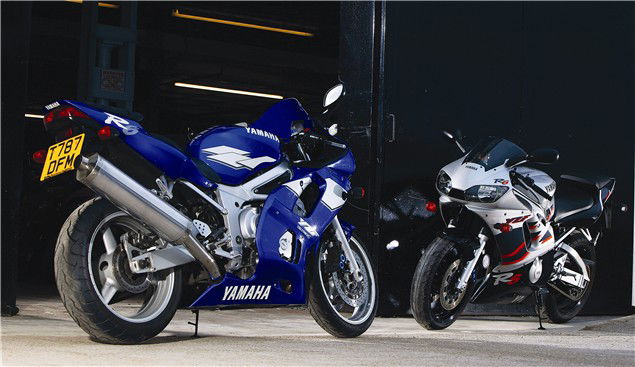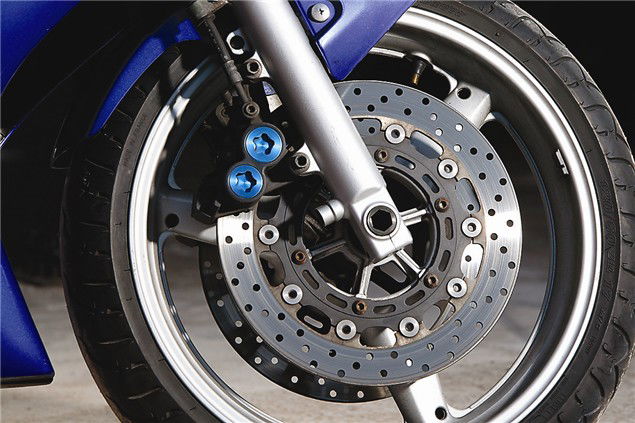Used Review: Yamaha YZF-R6
Yamaha's feisty little R6 has deservedly gained a cult status amongst its fans, as a rev-happy, sharp-edged alternative to Honda's more easy-going CBR600.

 |
THE YZF-R6 was Yamaha's hard-edged answer to the dominance of Honda's CBR600.
It re-visited what Yamaha 600s had been doing best up until the launch of the Thundercat in 1996. The R6 was edgy, raw, uncompromising, revvy and fast, where the lap-Cat had been the sensible man's choice - big, comfy and more than capable of going two-up in comfort or heading Europe-side for a spot of touring.
Like the FZR600 a few years before it, the R6 became the racer on the road compared to the then more sensible offerings from Honda and Kawasaki.
While Honda chose to straddle the middle of the supersport road with just one model - the Honda CBR600F - and Kawasaki was following suit with the then sane ZX-6R, Yamaha (and Suzuki, for that matter) went headfirst down the 'racey is right' route with their all-new sports 600.
But Yamaha out-did even Suzuki for the sporting feel of its new 600. Part of the R6's appeal is it's almost two-stroke willingness to rev, right up to that 15,500rpm redline. The first R6 came with a 'claimed' 120bhp (more like 105bhp at the rear wheel) and was also the first production bike to boast 200bhp per litre.
But these figures only tell half the story. What did make the bike the success it became was its single-minded attitude to sports biking and, from 1999, a close affinity to Yamaha's ground breaking R1, the bike that re-wrote the litre class rules. Little wonder that the R6 shared the R1's motto of 'no compromise.'
Today, early examples of the R6 still have the same attitude but, as we found with our two examples on the right, they can suffer all too easily from hard use, misuse and abuse - you can't make a hooligan tool without attracting hooligan riders.
Read on and tread carefully.
HEADBEARINGS
Many owners complain of steering head bearings coming loose - this may be from cack-handed wheelie landing or stoppies. You'll hear and feel a clunking from the front-end under braking during a test ride. Alternatively, get the front end in the air and push and pull the front wheel to feel for play
FRONT BRAKES
Original R6s models had stonking brakes - the same single-piece calipers as on the R1 - the years haven't been kind and the competition has moved things on. Older models' calipers need regular stripping and cleaning as dirt degrades performance and leads to sticking/binding brakes. On later models, go for a pad change and switch to aftermarket braided hoses
FRONT FORKS
Check the forks for any seal damage. Some owners report fork seals splitting easily - again, crap wheelie landings can be the cause
FRONT TYRE
Since the bike's launch in 1998, the front tyre has come as a 120/60, equating to a vague feel at big lean angles. You can swap to a 120/70 front, but pay attention. On 2003-on models Pirelli and Metzeler list some 120/70 fitments for the R6, but not on earlier bikes - there isn't enough space under the mudguard without re-mounting it slightly higher up, which isn't as hard as it sounds. The new tyre also changes the geometry, lifting the front of the bike and slowing the steering. To compensate, drop the yokes down the forks by 8-10mm. If all this seems a bit of a pain, buy a new R6 that comes with a 120/70 front end as standard
SIDESTAND
Early R6s were recalled for a sidestand switch and screws after safety concerns. If you're unsure if it's been done, call Yamaha UK ((01932) 358000) with your engine and chassis numbers. They'll know
GEARBOX
A bit of a problem area. The detention spring can break (this used to happen on early R1s too) meaning you can't select second gear properly or at all. Later production models had a beefier spring. Early models have been criticised for poor gear selection
FINISH
Not the strongest of areas, but much improved post-'03. Some owners complain of paint cracking on tanks and wheels. Keep on top of them with the cleaning products and they'll be fine, but some young Jack-the-lads neglect 'em and it's hard to get them back into decent shape. One of our 'TWO minutes with' bikes is a prime example. Clean shocks and wheels point to an owner who cares. Go for these bikes, not the dogs
ENGINE
There's little to be getting on with below 8000rpm, but keep it above 10,000rpm and you'll have serious fun all the way to the redline at 15,500rpm. If you want more than the 100-110bhp at the back wheel, then a pipe and Dynojet kit are the most popular mods for carbed versions. Expect a 10% gain for a full system and properly set-up jetting kit, at best a 5% increase with a slip on. 2003-on fuel-injected models don't need any more than an end-can mated to Dynojet's superb Power Commander. No major reliability concerns, even from high-mileage motors, although a few owners have experienced worn valve guides. Service intervals are every 4000 miles. Some problems reported. A number of owners have had cam-chain tensioners replaced under warranty at around the 10,000-mile mark. Listen for the familiar rattling sound. Some owners claim the noise gets worse after a switch to fully synthetic oil
FUEL CONSUMPTION
Pretty good for such a frenetic rev-monster. From the early carburettor models to the fuel-injected beasties, you're looking at an average of around 115-120 miles until the fuel light comes on (you'll squeeze around 25 miles from reserve). And when the light does come on, a reserve trip meter appears so you know exactly how many miles you've done on reserve. Genius
Yamaha YZF-R6 (1999-2001)
Price new £6299
Pay now £2500-£4500
Colours blue, red-white-black, silver, yellow
The first of the many. Nothing much at all was carried over from the Thundercat, this was an all-new, race-focussed screamer for the road. From 2001 to 2003 the bike received minor updates including an aesthetic freshen-up and new lights front and rear
Yamaha YZF-R6 (2003-2004)
Price new £7300
Pay now £4500-£6000
Colours red, blue, silver, black
Major update on engine, chassis and looks. Now comes with R1-style fuel-injection system and comes with added civility, but retains the original bike's looks, sharp handling and screaming top
Yamaha YZF-R6 (2005-on)
Price new £6599
Colours red, blue, silver, Rossi-rep (called the 'R46')
Looks very similar to the previous model, but now comes with upside-down forks and that 120/70 front tyre as standard

THE YZF-R6 was Yamaha's hard-edged answer to the dominance of Honda's CBR600.
It re-visited what Yamaha 600s had been doing best up until the launch of the Thundercat in 1996. The R6 was edgy, raw, uncompromising, revvy and fast, where the lap-Cat had been the sensible man's choice - big, comfy and more than capable of going two-up in comfort or heading Europe-side for a spot of touring.
Like the FZR600 a few years before it, the R6 became the racer on the road compared to the then more sensible offerings from Honda and Kawasaki.
While Honda chose to straddle the middle of the supersport road with just one model - the CBR600F - and Kawasaki was following suit with the then sane ZX-6R, Yamaha (and Suzuki, for that matter) went headfirst down the 'racey is right' route with their all-new sports 600.
But Yamaha out-did even Suzuki for the sporting feel of its new 600. Part of the R6's appeal is it's almost two-stroke willingness to rev, right up to that 15,500rpm redline. The first R6 came with a 'claimed' 120bhp (more like 105bhp at the rear wheel) and was also the first production bike to boast 200bhp per litre.
But these figures only tell half the story. What did make the bike the success it became was its single-minded attitude to sports biking and, from 1999, a close affinity to Yamaha's ground breaking R1, the bike that re-wrote the litre class rules. Little wonder that the R6 shared the R1's motto of 'no compromise.'
Today, early examples of the R6 still have the same attitude but, as we found with our two examples on the right, they can suffer all too easily from hard use, misuse and abuse - you can't make a hooligan tool without attracting hooligan riders. Read on and tread carefully.








